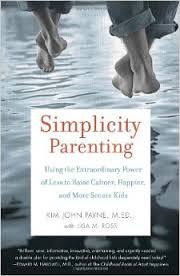We end our reading of “Simplicity Parenting” today and begin reading “Kids, Parents, and Power Struggles” by Mary Sheedy Kurcinka. I’ve thoroughly enjoyed reading “Simplicity Parenting” with you and listening to Kim John Payne’s teleseminar. How did you enjoy reading this book?
We haven’t discussed Chapter 6 “Filtering Out the Adult World” or the Epilogue to end this series of blog posts. In Chapter 6, what I found most refreshing was reading how we need to talk less and listen more to our children. We feel that talking provides our children with emotional intelligence but really the more we talk, the less we are listening. I’ve noticed this with my own daughter. She loves when we walk the neighborhood and I just listen to her talking. I love it too because I learn so much about her life, her mind, and her emotions during this time period. He also talks about the different parenting strategies that fall into the category of helicopter parenting. He discusses each one and the effects on your child and your relationship. Lastly, of the points that resonated with me, he says, “Before you say something, ask yourself these three questions: Is it true? Is it kind? Is it necessary?” I’m going to take that to heart and try to remember these questions as I speak not only to my daughter but to those around me.
The Epilogue was a great way to round up the book. He talks about the importance of simplification in discipline as well. That we offer our children too many choices now and how that overloads their system. He says to start with the simplification step that seems most doable first and then move onto the others. Simplification is a process but a rewarding one for your family. To end with, I love this passage of his on 215: “When you act to limit what you don’t want for your family, you clarify what you really do need, what is important to you. Your values clarify. Simplification is a path of self-definition for the family.”
There was of course more valuable information in these chapters that I encourage you to read. I look forward to reading “Kids, Parents, and Power Struggles” with you. Join us at anytime on GoodReads to start your own discussions of the books.


 Two passages that stood out to me are below:
Two passages that stood out to me are below:
